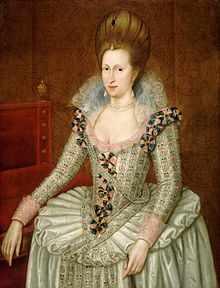
Back آن من الدنمارك Arabic ان من الدنمارك ARZ Ana de Dinamarca AST Danimarkalı Anna Azerbaijani Ганна Дацкая Byelorussian Анна Датска Bulgarian Anna Danmark (1574-1619) Breton Ana od Danske BS Anna de Dinamarca Catalan Anna Dánská Czech
| Anne of Denmark | |
|---|---|
 Portrait by John de Critz, 1605 | |
| Queen consort of England and Ireland | |
| Tenure | 24 March 1603 – 2 March 1619 |
| Coronation | 25 July 1603 |
| Queen consort of Scotland | |
| Tenure | 20 August 1589 – 2 March 1619 |
| Coronation | 17 May 1590 |
| Born | 12 December 1574 Skanderborg Castle, Skanderborg, Denmark |
| Died | 2 March 1619 (aged 44) Hampton Court Palace, Middlesex, England |
| Burial | 13 May 1619 Westminster Abbey, London, England |
| Spouse | |
| Issue Detail | |
| House | Oldenburg |
| Father | Frederick II of Denmark |
| Mother | Sophie of Mecklenburg-Güstrow |
| Signature | |
| Danish Royalty |
| House of Oldenburg Main Line |
|---|
 |
| Frederick II |
Anne of Denmark (Danish: Anna; 12 December 1574 – 2 March 1619) was the wife of King James VI and I. She was Queen of Scotland from their marriage on 20 August 1589 and Queen of England and Ireland from the union of the Scottish and English crowns on 24 March 1603 until her death in 1619.[1]
The second daughter of King Frederick II of Denmark and Sophie of Mecklenburg-Güstrow, Anne married James at age 14. They had three children who survived infancy: Henry Frederick, Prince of Wales, who predeceased his parents; Princess Elizabeth, who became Queen of Bohemia; and James's future successor, Charles I. Anne demonstrated an independent streak and a willingness to use factional Scottish politics in her conflicts with James over the custody of Prince Henry and his treatment of her friend Beatrix Ruthven. Anne appears to have loved James at first, but the couple gradually drifted and eventually lived apart, though mutual respect and a degree of affection survived.[2]
In England, Anne shifted her energies from factional politics to patronage of the arts and constructed her own magnificent court, hosting one of the richest cultural salons in Europe.[3] After 1612, she had sustained bouts of ill health and gradually withdrew from the centre of court life. Though she was reported to have been a Protestant at the time of her death, she may have converted to Catholicism at some point in her life.[4]
Some historians have dismissed Anne as a lightweight queen, frivolous and self-indulgent.[5] However, 18th-century writers including Thomas Birch and William Guthrie considered her a woman of "boundless intrigue".[6] Recent reappraisals acknowledge Anne's assertive independence and, in particular, her dynamic significance as a patron of the arts during the Jacobean age.[7]
- ^ Williams, 1, 201; Willson, 403.
- ^ Stewart, 182, 300–301.
- ^ Barroll, 15, 35, 109; "Although Anna had considerable personal freedom and her own court, she does not appear to have intervened so visibly against her husband in factional politics as she did in Scotland, and her support was not often sought. Where the Queen's court came into its own was as an artistic salon." Stewart, 183.
- ^ The Archbishop of Canterbury reported that she had died rejecting Catholic notions. "But, then," cautions historian John Leeds Barroll, "we are all familiar with the modern 'press release'. In Anna's day, too, there was much to be said for promulgating an official version of England's queen dying 'respectably'." Barroll, 172; A letter from Anne to Scipione Borghese of 31 July 1601 is "open in its embrace of Catholicism", according to McManus, 93.
- ^ Agnes Strickland (1848), 276 Retrieved 10 May 2007; Willson, 95; "Her traditionally flaccid court image ..." Barroll, 27; Croft, 55; "Anne had proved to be both dull and indolent, though showing a certain tolerant amiability so long as her whims were satisfied. She was interested in little that was more serious than matters of dress." Akrigg, 21.
- ^ William Guthrie, History of Scotland, vol. 10 (London, 1768), p. 6: Thomas Birch, Memoirs of the reign of Queen Elizabeth, vol. 1 (London, 1754), p. 242.
- ^ "She quickly moved vigorously into court politics, an aspect of her new life not foregrounded by her few biographers ... she soon became a political presence at the Scottish court." Barroll, 17; "Though she has been accorded insufficient attention by historians, James's Queen, Anne of Denmark, was politically astute and active." Sharpe, 244; "This new king's influence on the high culture of the Stuart period, although considerable in certain discrete areas, has been misunderstood in terms of innovations at the court itself ... during the first decade of his reign, these innovations were fundamentally shaped by James's much neglected queen consort, Anna of Denmark." Barroll, 1–2.
© MMXXIII Rich X Search. We shall prevail. All rights reserved. Rich X Search